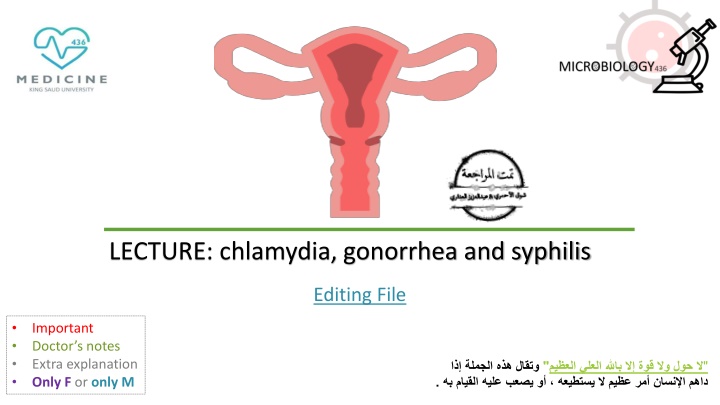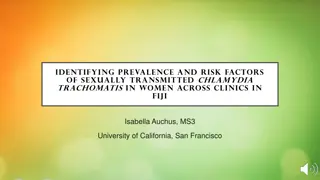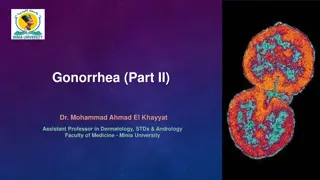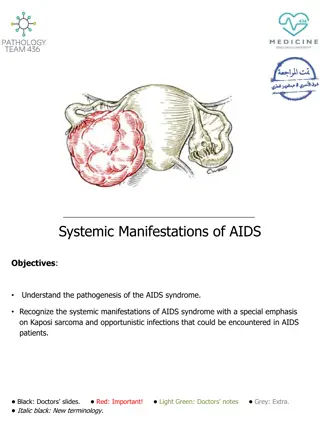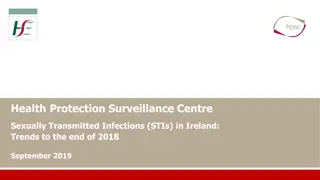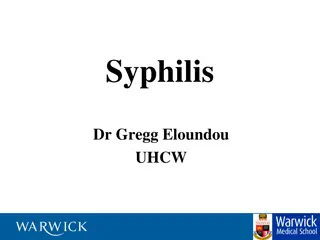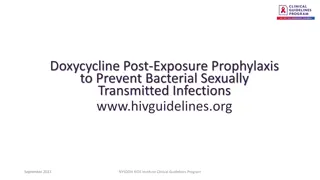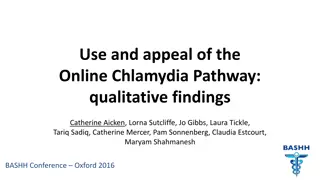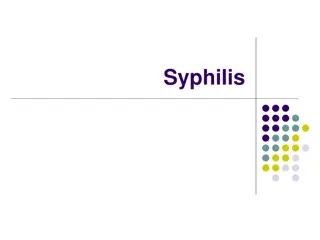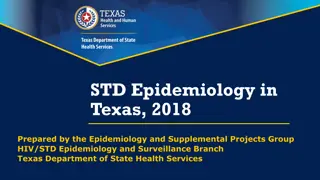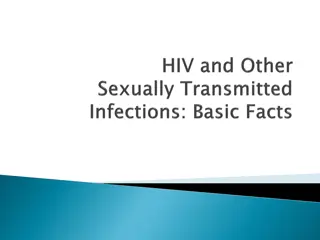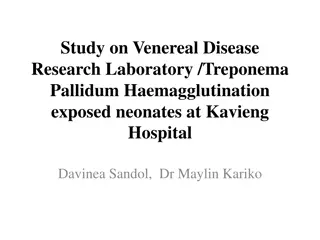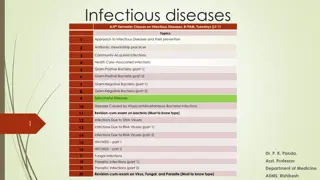Chlamydia, Gonorrhea, and Syphilis Infections
This lecture provides detailed insights into the causative agents, pathogenesis, clinical features, and laboratory diagnosis of chlamydia, gonorrhea, and syphilis infections. It also covers different diagnostic methods, treatment regimens, and the lack of effective vaccines for these sexually transmitted diseases. Focus is placed on Chlamydia trachomatis, its epidemiology, pathogenesis, and potential complications, especially in women.
Download Presentation

Please find below an Image/Link to download the presentation.
The content on the website is provided AS IS for your information and personal use only. It may not be sold, licensed, or shared on other websites without obtaining consent from the author.If you encounter any issues during the download, it is possible that the publisher has removed the file from their server.
You are allowed to download the files provided on this website for personal or commercial use, subject to the condition that they are used lawfully. All files are the property of their respective owners.
The content on the website is provided AS IS for your information and personal use only. It may not be sold, licensed, or shared on other websites without obtaining consent from the author.
E N D
Presentation Transcript
LECTURE: chlamydia, gonorrhea and syphilis Editing File Important Doctor s notes Extra explanation Only F or only M " " .
OBJECTIVES: Recall the causative agents of syphilis, gonorrhea and Chlamydia infections. Describe the pathogenesis of syphilis, gonorrhea and Chlamydia infection. Describe the clinical features of Chlamydial infections Recall the different genera, species and serotypes of the family Chlamydophila. Describe the laboratory diagnosis of Chlamydia Describe the clinical features of gonorrhea that affect only men, only women and those ones which affect both sexes.
OBJECTIVES: Describe the different laboratory tests for the diagnosis of gonorrhea Describe the clinical feature of the primary, secondary tertiary syphilis and complications. Recall the different diagnostic methods for the different stages of syphilis. Recall the treatment regimens of syphilis, gonorrhea and Chlamydia infections. Recall that there are no effective vaccines against all these three diseases.
Chlamydia An obligate intracellular bacteria with elements of bacteria but no rigid cell wall. Fail to grow on artificial media Uses host cell metabolism for growth and replication. It lives only inside the cell, so we cannot culture it in the lab without human tissue in order to survive & replicate General info This is the life cycle, start with elementary body which is the infective body which enter the cells and start to replicate and develop into reticulate body is not infectious and this body continue to replicate and concentrate to form inclusion, at the end it will convert back to elementary body and start to infect other cells. So elementary body is the most infective part of chlamydia. A,B,C, D-K L1,L2,L3 C.psittaci C.pneumoniae serotype C. trachomatis: Trachoma Inclusion conjunctivitis, genital infection Lymphogranuloma venerum (LGV) Psittacosis Respiratory infections diseases most common cause of blindness in the past Our concern here about sexually transmitted disease
Chlamydia trachomatis Epidemiology of c.trachomatis C.trachomatis is a common cause of sexually transmitted disease (STD). Spread by genital secretions , anal or oral sex. Wide spread, 5-20 % among STD clinic in USA. Human are the sole reservoir Human is the only reservoir . 1/3 of male sexual contacts of women with C.trachomatis cervicitis develop urethritis after 2-6 weeks incubation period It has long IP . The majority of women who have a sex with male who is having chlamydia, they don t develop symptoms Pathogenesis of chlamydia species Chlamydia have tropism for epithelial cells of endocervix and upper genital tract of women, urethra, rectum and conjunctiva of both sexes. That s why sometimes conjunctivitis especially in babies may be caused by chlamydia trachomatis if the mother was infected. LGV can enter through skin or mucosal breaks When chlamydia enter the cells, Release of pro-inflammatory cytokines, lead to tissue infiltration by inflammatory cells, progress to necrosis, fibrosis then scaring. May lead to infertility In women: cervicitis, salpingitis, urethral syndrome, endometritis & proctitis. Uterine cervix infection may produce vaginal discharge but is asymptomatic in 50-70% of women. Salpingitis and pelvic inflammatory disease can cause sterility and ectopic pregnancy. So the majority of women are asymptomatic with no symptoms. This is very dangerous, because the women with no symptoms may spread the infection to others or even progress without seeking the disease Genital infections caused by c.trachomatis In men: urethritis ( non gonococcal urethritis (NGU))* , epididymitis & proctitis. Urethritis presents as dysuria and thin urethral discharge in 50 % of men. sever pain along with thick purulent discharge << this is very important In contrast with N.gonococcal which cause * More of the symptoms are presented in male usually present with urethritis , it resemble urethritis caused by bacterial causes such as E.coli and N.Gonococcal, if the culture is negative for these causes, here we should consider non gonococcal urethritis mainly due to chlamydia trachomatis.
Chlamydia trachomatis Other diseases caused by c.tracomatis 50% of infants born to mothers excreting C.trachomatis during labor show evidence of infection during the first year of life. Most develop inclusion conjunctivitis With discharge from the eyes , 5-10% develop infant pneumonia syndrome. LGV caused by C.trachomatis strains L1,L2,L3 LGV is common in South America and Africa. Papule and inguinal lymphadenopathy. Chronic infection leads to abscesses, strictures and fistulas. the most sensitive methods of diagnosis. Performed on vaginal ,cervical , urethral swabs, or urine . Isolation on tissue culture ( McCoy cell line) : C.trachomatis inclusions can be seen by iodine or Giemsa stained smear. (Rarely done) Which are reticulate body What other cause of eye discharge in the baby ? N.gonococcal with profuse discharge Staphylococcus pneumoniae Haemophilus influenza Diagnosis of chlamydia species causing genital infections Polymerase chain reaction (PCR) : Of nucleic acid In the past, it takes weeks Prevention and control through early detection of asymptomatic cases , screening women under 25 years to reduce transmission to the sexual partner. Treatment and prevention Azithromycin : single dose for non- LGV infection. Erythromycin : for pregnant women. Doxycycline : for LGV.
Gonorrhea General info A STD disease acquired by direct genital contact. It is localized to mucosal surfaces with infrequent spread to blood or deep tissues. Caused by N.gonorrheae. Clinical manifestations 2-5 days IP It is short in compared with other STD . Men: acute urethritis and acute profuse purulent urethral discharge. Women: mucopurulent cervicitis, urethritis with discharge, Pelvic inflammatory disease ( PID) in women. In both sexes: proctitis & urethritis . Symptoms are similar to Chlamydia infection. Pharyngitis may occur. Conjunctivitis in neonates born to infected mothers We suspect this infection in young sexually active period not in 70 years old male . Due to oral sex Prevention and control through early detection of asymptomatic cases , screening women under 25 years to reduce transmission to the sexual partner. Treatment and prevention Azithromycin : single dose for non- LGV infection. Erythromycin : for pregnant women. Doxycycline : for LGV.
Pelvic inflammatory disease (PID) & disseminated gonococcal infection (DGI): Pelvic inflammatory disease (PID) & disseminated gonococcal infection (DGI): Pelvic inflammatory disease: Some women who are not treated, they may develop PID o PID occurs in 10-20% of cases, include fever, lower abdominal pain, adnexal tenderness, leukocytosis with or without signs of local infection. o Salpingitis and pelvic peritonitis cause scarring and infertility. Chlamydia and N.gonococcal are the most common bacterial cause of infertility. o Disseminated Gonoccocal Infection ( DGI) due to spread to the bloodstream Which is very rare. disseminated gonococcal infection: o Due to spread of the bacteria to the blood stream, Clinically: o Fever, migratory arthralgia and arthritis. Purulent arthritis involving large joints. Petechial and maculopapular rash. o Metastatic infections such as Endocarditis , Meningitis & Perihepatitis may develop.
Neisseria Gonorrhea General info . A Gram negative diplococci grows on chocolate agar and on selective enriched media and CO2 required. Not a normal flora. In N.meningitidis is growth in chocolate agar, while N.gonorrheae it order to isolate on selective media which contain antibiotic direct against other bacteria such as normal flora in genital tract. pathogenesis mainly a localized infection of epithelium ,leads to intense inflammation. Posses pili and outer membrane proteins that mediate attachment to non-ciliated epithelium. epidemiology Rates among adolescents are high, about 10% increase per year in USA . Inability to detect asymptomatic cases such as women and patient fail to seek medical care hampers control Major reservoir for continued spread are asymptomatic cases. Non-sexual transmission is rare. diagnosis Transport media required unless transfer to the lab. is immediate. Gram stain: Direct smear for Gram stain of urethral specimens to see Gram negative diplococci within a neutrophil (intracellular) . Culture: Culture on Thayer-Martin or other selective medium. Confirmation : fermentation of glucose only ( does not ferment maltose or sucrose) or Co-agglutination test. Nucleic acid amplification tests (e.g PCR) is an option for diagnosing genital infections N.Gonorrheae = Glucose only N.Meningitidis = maltose and. Glucose Other Neisseria spices as normal flora = glucose, maltose, sucrose and. Starch
Gonorrhea treatment Guided by local resistance pattern and susceptibility testing. Partner should be treated as well. Ceftriaxone IM (or oral Cefixime ) recommended. Combination with Azithromycin recommended Alternatives: Ciprofloxacin or Ofloxacin Azithromycin, Doxycycline ( orally for 7 days) both cover C.trachomatis infection as well . Counseling. This is co-agglutination with specific antibiotic This is gram stain with many. White blood cells, and we can see N.gonorrheae as gram negative diplococci inside thee neutrophils
http://t2.gstatic.com/images?q=tbn:rDBxWveglHS_vM:http://s99.middlebury.edu/BI330A/projects/MAtt/Syphilis/tpal.gifhttp://t2.gstatic.com/images?q=tbn:rDBxWveglHS_vM:http://s99.middlebury.edu/BI330A/projects/MAtt/Syphilis/tpal.gif Syphilis: Syphilis: Features A chronic systemic infection , sexually transmitted , caused by a spiral organism called Treponema pallidum subsp.pallidum . this bacteria is very tiny so we can t see it by gram stain. And also can t be culture because it needs living tissues The organism grow on cultured mammalian cells only , NOT stained by Gram stain but readily seen only by immunoflurescence (IF), dark filed microscopy or silver impregnation histology technique. Epidemiology An exclusively human pathogen. Transmission by contact with mucosal surfaces or blood, less commonly by non-genital contacts with a lesion, sharing needles by IV drug users, or transplacental transmission to fetus. Early disease is infectious. Late disease is not infectious Is transmitted by blood, that s why during blood transfusions we screening for syphilis with HIV & hepatitis B and C. pathogenesis Bacteria access through inapparent skin or mucosal breaks. Slow multiplication , endarteritis & granulomas. Start. With ulcer which is not painful Ulcer heals but spirochete disseminate. Latent periods may be due to surface binding of host components. Injury is due to delayed hypersensitivity responses to the persistence of the spirochetes. Endarteritis Cause all over the body arthritis in small artery cause inflammation that s why it is systemic disease
Clinical manifestations Primary syphilis chancre is a painless, indurated ulcer with firm base and raised margins on external genitalia or cervix ,anal or oral site, appear after an IP of about 2-6 weeks . The other causes of painful ulcer in genitalia is herpes Enlarged inguinal lymph nodes may persist for months. Lesion is infectious Lesion heals spontaneously after 4-6 weeks. Secondary syphilis Develops 2-8 weeks after primary lesion healed. Characterized by symmetric mucocutaneous rash , mouth lesions ( snail track ulcers) and generalized non-tender lymph nodes enlargement ( full of spirochete) with bacteremia causing fever, malaise and other systemic manifestations. Skin lesion distributed on trunk and extremities often palms, soles and face. 1/3 develop Condylomata Lata: which are painless mucosal warty erosions on genital area and perineum. Secondary lesion resolve after few days to many weeks but disease continue in 1/3 of patients. Disease enter into a latent state. Lesions are infectious.
Clinical manifestations Latent syphilis a stage where there is no clinical manifestations but infection evident by serological tests. Relapse cease. Risk of blood-borne transmission from relapsing infection or mother to fetus continue Tertiary syphilis Occurs in 1/3 of untreated cases. Manifestations may appear after 15-20 years or may be asymptomatic but serological tests positive. Neurosyphilis: chronic meningitis, with increased cells and protein in CSF, leads to degenerative changes and psychosis. Demylination causes peripheral neuropathies. Most advanced cases result in paresis is a shortcut (personality, affect , reflexes, eyes, senorium, intellect, speech) due to the effect on the brain parenchyma and posterior columns of spinal cord and dorsal roots. Cardiovascular syphilis: Due to arteritis, leads to aneurysm of aorta and aortic valve ring. Localized granulomatous reaction called gumma on skin, bones, joints or other organs leads to local destruction . Congenital syphilis : develop if the mother not treated ,fetus susceptible after 4th month of gestation. Fetal loss or congenital syphilis result. Rhinitis ,rash and bone changes ( saddle nose, saber shine) anemia ,thrombocytopenia, and liver failure
interpretation of serological tests for syphilis: Positive nontreponemal tests and specific treponemal test is positive= the patient has syphilis If the nontreponemal tests positive and treponemal test is negative= no syphilis Nontreponemal tests Negative and treponemal tests positive= previously treated Both negative? no syphilis
Diagnosis (mainly depends on serology) 1. Dark field microscopy: of smear from primary or secondary lesions. May be negative. 2. Silver impregnation: is diagnostic to 1ry stage 3. Serologic tests: Diagnosis mainly by more commonly used as they are easier to perform. Include: 1-Nontreponemal tests* (nonspecific): antibody to cardiolipin** (lipin = a lipid complex, cardio= extracted from beef heart), this Ab. (cardiolipin) is called reagin . The tests are called: rapid plasma reagin (RPR ) 25 and venereal disease research laboratory (VDRL) Become positive during the primary stage The chancre (possible exception: patients with HIV), antibody peak in secondary syphilis, then slowly wane in later stages. Positive in patients who have other diseases and in pregnant and in hepatitis and other Infection but mainly Treponema pallidum syphilis - Used for screening and follow up. But not for conformation We use it in screening of primary and secondary syphilis or we use it to check if the patient is responding to treatment, but it is not specific to syphilis. If the patient is positive to RPR we have to do confirmatory test. If it is negative he doesn't have syphilis. CONTINUO NEXT SLIDE * Non specific and does not use anti this bacteria but it give us a hint that this patient may have syphilis ** It is found in mitochondria of all living Tissue even in bacteria
Diagnosis (mainly depends on serology) Last slide 2- Treponemal tests : using treponemal antigen to detect specific antibody to T.pallidum by: A- Fluorescent Treponemal Antibody (FTA-ABS ) specific & + in early stages B- Microhemagglutination test (MHA-TP ) (antigen attached to erythrocytes) - I put buffer so i can delete the non treponemal pallidum. - This is positive at all stages and VDRL. 3. Serologic tests: Diagnosis mainly by more commonly used as they are easier to perform. Include: - Positive results of treponemal test confirm RPR 3- IgM used to diagnose congenital syphilis. Treatment and prevention Treatment: Treponema is sensitive to Penicillin, but hypersensitive patients are treated with Tetracycline, Erythromycin or Cephalosporin. Prevention: counseling
Syphilis: Syphilis: typical for syphilis
Take home message: Take home message: Syphilis, Chlamydia and Gonorrhea are main STDs ,caused by delicate organisms ,cannot survive outside the body. Infection may not be localized. Clinical presentation may be similar ( urethral or genital discharge, ulcers ). One or more organisms ( Bacteria, virus, parasite ) may be transmitted by sexual contact. Screening for HIV required . If not treated early may end in serious complications
A special thanks to team microbiology 435 for this wonderful summary!
QUIZ: 2-which infection is most infectious: A- primary B- secondary C- tertiary D- none of them 1-which of the following can cause Psittacosis: A- Dog B- cat C- Parrot D- Fish Answers: 1. D`2.C 3.A
THANK YOU FOR CHECKING OUR WORK, BEST OF LUCK! Shrooq Alsomali Ghada Alskait Rawan Alqahtani Nawaf alkhudhayri Basel almeflh Doctors slides
